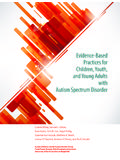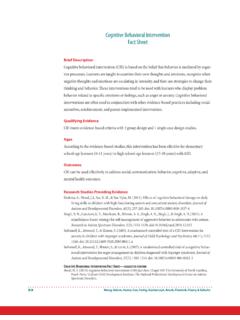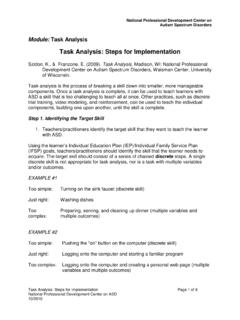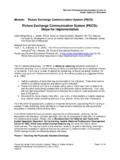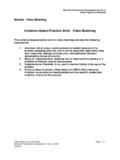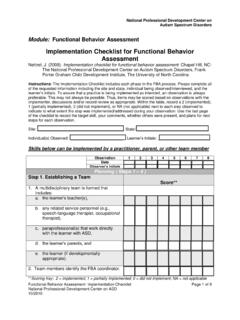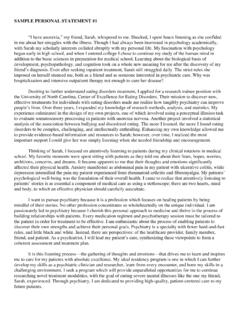Transcription of Evidence-Based Practice Brief: Discrete Trial Training (DTT)
1 National Professional Development Center on Autism Spectrum Disorders Module: Discrete Trial Training (DTT) Discrete Trial Training : Cover Sheet Page 1 of 1 National Professional Development Center on ASD 10/2010 Evidence-Based Practice Brief: Discrete Trial Training (DTT) This Evidence-Based Practice brief on Discrete Trial teaching includes the following components: 1. Overview, which gives a quick summary of salient features of the Practice , including what it is, who it can be used with, what skills it has been used with, settings for instruction, and additional literature documenting its use in Practice 2. Steps for Implementation, detailing how to implement the Practice in a practitioner-friendly, step-by-step process 3. Implementation Checklist, to be used to monitor fidelity of the use of the Practice 4.
2 Evidence Base Summary, which details the NPDC-ASD criteria for inclusion as an Evidence-Based Practice and the specific studies that meet the criteria for this Practice 5. Discrete Trial Training data collection sheets National Professional Development Center on Autism Spectrum Disorders Module: Discrete Trial Training (DTT) Discrete Trial Training : Overview Page 1 of 3 National Professional Development Center on ASD 10/2010 Overview of Discrete Trial Training Bogin, J. (2008). Overview of Discrete Trial Training . Sacramento, CA: National Professional Development Center on Autism Spectrum Disorders, Institute, The University of California at Davis Medical school . Discrete Trial Training (DTT) is a one-to-one instructional approach used to teach skills in a planned, controlled, and systematic manner.
3 DTT is used when a learner needs to learn a skill best taught in small repeated steps. Each Trial or teaching opportunity has a definite beginning and end, thus the descriptor Discrete Trial . Within DTT, the use of antecedents and consequences is carefully planned and implemented. Positive praise and/or tangible rewards are used to reinforce desired skills or behaviors. Data collection is an important part of DTT and supports decision making by providing teachers/practitioners with information about beginning skill level, progress and challenges, skill acquisition and maintenance, and generalization of learned skills or behaviors. Evidence DTT meets the Evidence-Based Practice criteria within the early childhood and elementary age groups for promoting the development of communication/language, adaptive behavior, cognitive/academic skills, social and play skills, and for reducing interfering behaviors.
4 With what ages is DTT effective? DTT can be used to teach students from early childhood through elementary school at all ability levels. Due to the intensive and repetitive nature of DTT, there is more evidence for using DTT with younger children ( , 2 to 9 years of age). What skills or intervention goals can be addressed by DTT? DTT has been shown to have positive effects on children s academic, cognitive, communication/language, social, and behavioral skills. DTT can also be used to teach attending, imitation, and symbolic play skills. Where has DTT been effectively used? DTT can be taught in home, school , or community settings. Because Discrete trials are often carried out in an intensive and repetitive fashion, quiet areas with limited distractions are often used.
5 Evidence Base National Professional Development Center on Autism Spectrum Disorders Module: Discrete Trial Training (DTT) Discrete Trial Training : Overview Page 2 of 3 National Professional Development Center on ASD 10/2010 The studies cited in this section document that this Practice meets the NPDC on ASD s criteria for an Evidence-Based Practice . This list is not exhaustive; other quality studies may exist that were not included. Preschool Cohen, H., Amerine-Dickens, M., & Smith, T. (2006). Early intensive behavioral treatment: Replication of the UCLA model in a community setting. Journal of Developmental and Behavioral Pediatrics, 27(2), 145-155. Howard, J. S., Sparkman, C. R., Cohen, H. G., Green, G., & Stanislaw, H. (2005). A comparison of intensive behavior analytic and eclectic treatments for young children with autism.
6 Research in Developmental Disabilities, 26(4), 359-383. Remington, B., Hastings, , Kovshoff, H., Degli Espinosa, F., Jahr, E., Brown T., et al. (2007). Early intensive behavioral intervention: Outcomes for children with autism and their parents after two years. American Journal on Mental Retardation, 112(6), 418-438. Smith, T., Groen, A., & Wynn, J. W. (2000). Randomized Trial of intensive early intervention for children with pervasive developmental disorder. American Journal on Mental Retardation, 105(4), 269-285. Whalen, C., & Schreibman, L. (2003). Joint attention Training for children with autism using behavior modification procedures. Journal of Child Psychology & Psychiatry, 44(3), 456-468. Elementary Dib, N., & Sturmey, P. (2007). Reducing student stereotypy by improving teachers' implementation of Discrete - Trial teaching.
7 Journal of Applied Behavior Analysis, 40(2), 339-343. Eikeseth, S., Smith, T., Jahr, E., & Eldevik, S. (2002). Intensive behavioral treatment at school for 4-7 year-old children with autism. Behavior Modification. 26(1), 49-68. Lovaas, O. I. (1987). Behavioral treatment and normal educational and intellectual functioning in young autistic children. Journal of Consulting and Clinical Psychology. 55, 3-9. National Professional Development Center on Autism Spectrum Disorders Module: Discrete Trial Training (DTT) Discrete Trial Training : Overview Page 3 of 3 National Professional Development Center on ASD 10/2010 McEachin, J. J., Smith, T., & Lovaas, O. I. (1993). Long-term outcomes for children with autism who received early intensive behavioral treatment.
8 American Journal on Mental Retardation, 97(4), 359-372. Selected Additional References Eikeseth, S., Smith, T., Jahr, E., & Eldevik, S. (2007). Outcomes for children with autism who began intensive behavioral treatment between ages 4 and 7: A comparison controlled study. Behavior Modification, 31(3), 264-278. Leaf, R., & McEachin J. (1999). A work in progress. New York, NY: Autism Partnership Lovaas, O. I., & Smith, T. (1989). A comprehensive behavioral theory of autistic children: Paradigm for research and treatment. Journal of Behavior Therapy and Experimental Psychiatry, 20, 17-29 Lovaas, O. I., Schreibman, L., Koegel, R., & Rehm, R. (1971). Selective responding by autistic children to multiple sensory input. Journal of Abnormal Psychology, 77(3), 211-222. Lovaas, O.
9 I., Ackerman, A. B., Alexander, D., Firestone, P., Perkins, J., & Young, D. (1981). Teaching developmentally disabled children: The ME book. Austin, TX: Pro-Ed. Lovaas, O. I., Koegel, R., Simmons, J., & Long, (1973). Some generalization and follow-up measures on autistic children in behavior therapy. Journal of Applied Behavior Analysis. 6(1), 131-166. Lovaas, O I., Schreibman, L., & Koegel, R. (1974). A behavior modification approach to the treatment of autistic children. Journal of Autism and Childhood Schizophrenia, 4(2), 111-129. Matson, J., Benavidez, D., Compton, L. S., Paclawskyj, T., & Baglio, C. (1996). Behavioral treatment of autistic persons: A review of research from 1980 to the present. Research in Developmental Disabilities, 17(6), 433-465. Maurice, C.
10 (1993). Let me hear your voice. NY: Knopf. Smith, T. (1999). Outcome of early intervention for children with autism. Clinical Psychology: Science and Practice , 6(1), 33-49. Taylor, B. A., & McDonough, K. A. (1996). Selecting teaching programs. In C. Maurice, G. Green, & S. C. Luce (Eds.). Behavioral intervention for young children with autism: A manual for parents and professionals (pp. 63-177). Autism, TX: Pro Ed. National Professional Development Center on Autism Spectrum Disorders Module: Discrete Trial Training (DTT) Discrete Trial Training : Evidence Base Page 1 of 2 National Professional Development Center on ASD 10/2010 Evidence Base for Discrete Trial Training The National Professional Development Center on ASD has adopted the following definition of Evidence-Based practices.
